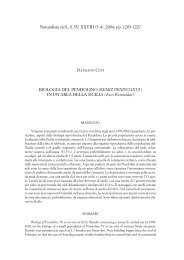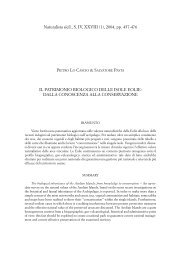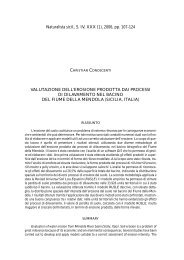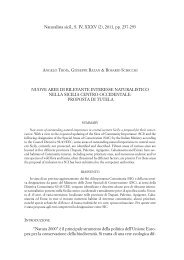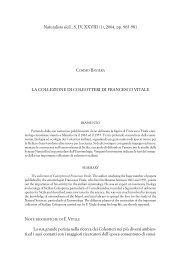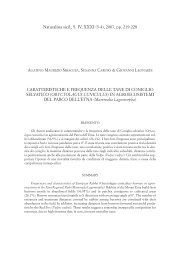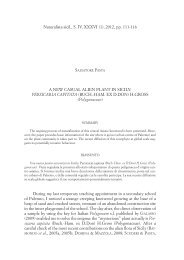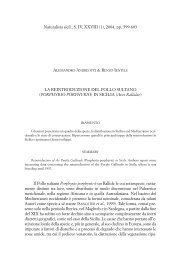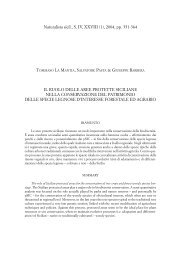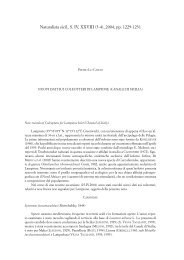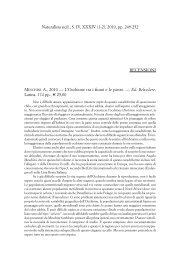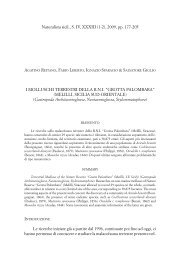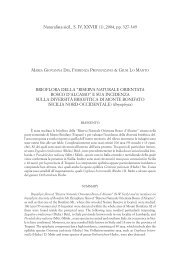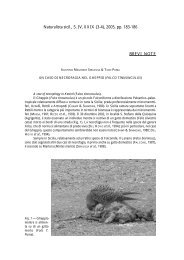2007,pp - Società Siciliana di Scienze Naturali
2007,pp - Società Siciliana di Scienze Naturali
2007,pp - Società Siciliana di Scienze Naturali
Create successful ePaper yourself
Turn your PDF publications into a flip-book with our unique Google optimized e-Paper software.
268 M. SKUHRAVÁ, V. SKUHRAVY´ & B. MASSA<br />
Ten. (= V. varia Host) (Fabaceae). KIEFFER (1909) described this species very<br />
briefly with the reference to MASSALONGO (1899). He found galls at Ferrara<br />
and in<strong>di</strong>cated the causer as “Cecidomyidarum sp.”. Occurrence: DE STEFANI<br />
(1903) found in Palermo galls on Vicia dasycarpa and V. sativa misidentifying<br />
the inducer as “?Clino<strong>di</strong>plosis bellevoyei Kieffer, 1896”. Distribution:<br />
Me<strong>di</strong>terranean.<br />
Aphidoletes aphi<strong>di</strong>myza (Rondani, 1847)<br />
Cecidomya aphi<strong>di</strong>myza Rondani, 1847; Phaenobremia aphi<strong>di</strong>myza (Rondani, 1847)<br />
Larvae are predators of many species of aphids (Hemiptera Aphi<strong>di</strong>dae).<br />
RONDANI (1847) described this species as Cecidomya aphi<strong>di</strong>myza from<br />
Italy. SOLINAS (1968) stu<strong>di</strong>ed the morphology and anatomy of the larva,<br />
HARRIS (1973) the biology, host range (61 species of aphids), field populations<br />
and geographical <strong>di</strong>stribution and on the basis of his comparative<br />
stu<strong>di</strong>es of large material established 14 synonyms. A. aphi<strong>di</strong>myza is used for<br />
biological control of aphids. Occurrence: LONGO et al. (2001) reported the<br />
presence of this species from the Etna region. The unidentified cecidomyiid<br />
recorded as a parasitoid of Aphis pariatariae in Sicily by MINEO et al.<br />
(1997) probably belongs to this species. Distribution: Holarctic, secondarily<br />
cosmopolitan.<br />
Apiomyia bergenstammi (Wachtl, 1882)<br />
Larvae cause woody, plurilocular galls on twigs of Pyrus communis L.<br />
(Rosaceae) (Pl. VI, Fig. 35). Original material came from Corfu (Greece) and<br />
was collected by J.E. Bergenstamm. Only one generation develops a year. Larvae<br />
overwinter in galls where they pupate in spring. DELLA BEFFA (1938)<br />
redescribed this species and stu<strong>di</strong>ed its biology in detail. This species a<strong>pp</strong>ears<br />
occasionally in the southern part of Europe as a pest (DARVAS et al., 2000).<br />
Occurrence: DE STEFANI (1917) recorded the presence of A. bergenstammi in<br />
Sicily without giving a locality. Distribution: south European and Me<strong>di</strong>terranean,<br />
reaching up to Turkey (SKUHRAVÁ et al., 2005).<br />
Aplonyx chenopo<strong>di</strong>i De Stefani, 1908<br />
Larvae develop in plurilocular swellings on stems of Atriplex patula (L.)<br />
(Chenopo<strong>di</strong>aceae). DE STEFANI (1907b) first recorded it as an unidentified<br />
species; afterwards he (1908b) described it as a new species, giving<br />
Chenopo<strong>di</strong>um album L. as its host plant species. TROTTER & CECCONI (1900-<br />
1917, fasc.XIX, N.455) reported that the correct host plant is “Atriplex hastatum,<br />
var. patulum”; we found also that this opinion was handwritten by T.<br />
De Stefani in his original papers of 1907 and 1908 (Fig. 2). The gall is similar



